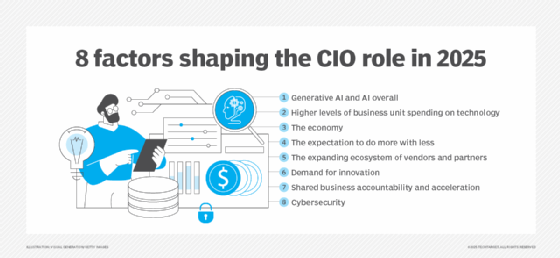8 factors reshaping the role of the CIO in 2025
Bring us the money. Heading into 2025, CIOs face increasing pressure to drive revenue, savings and business value from their technology initiatives, particularly in AI.
Organizations continue to see technology as their key to future success and growth, leading to healthy levels of increased IT spending in 2025.
Research and advisory firm Gartner estimated that worldwide IT spending will hit $5.74 trillion next year, up 9.3% from 2024.
"The 2025 State of IT" report from Spiceworks, a global technology digital marketplace, had similar numbers, finding that 64% of businesses plan to increase their IT budgets in 2025 with IT spending expected to grow 9% year over year.
That money, though, has strings attached: CIOs are expected to deliver returns on all that spending. They're expected to advance their organization's use of AI by identifying areas where it can produce tangible business values. They're expected to drive further transformation. And they're increasingly being asked to develop revenue-generating initiatives.
Those are just several of the demands that are driving CIO responsibilities and priorities in 2025, according to analysts, researchers, executive consultants and CIOs. Here are factors influencing the role of the CIO.
1. Generative AI and AI overall
Since generative AI (GenAI) appeared in late 2022, companies have been seeking ways to use the technology to deliver productivity gains, efficiencies, increased revenue and transformation.
This article is part of
The evolving CIO role: From IT operator to business strategist
Those high expectations continue into 2025. More than half (58%) of the 355 CIOs, CTOs, IT directors and technology leaders surveyed in "The Impact of Technology in 2025 and Beyond: an IEEE Global Study," cited AI as the most important area of tech in the year ahead.
Meanwhile, CEOs remain convinced that GenAI is a transformative technology: 68% of U.S. CEOs in PwC's "27th Annual Global CEO Survey" said GenAI will significantly change how their company creates and delivers value. And there's the rub for CIOs.
"CEOs want CIOs to do more than experiment with AI and GenAI more specifically," said Yugal Joshi, partner at global research and management consulting firm Everest Group. "They expect CIOs to find, build and scale the AI use cases that will deliver business value." And that, he added, "is becoming a big challenge.
According to the "2024 KPMG US Technology Survey Report: The digital dividend," only 39% of the surveyed organizations have AI use cases delivering business value.

2. Higher levels of business unit spending on technology
Business units continue to make their own investments in technology, and that is changing how CIOs manage tech within their enterprise, experts said.
''We have continued to pivot to citizen developers," said RJ Juliano, senior vice president, CIO and chief marketing officer at Parkway Corp., a real estate and parking investment, development and operations company.
He said moving into 2025 "more people outside IT will have the tools they need to create, integrate and scale."
That, however, puts pressure on CIOs and IT to ensure those business unit workers have the security, stability and scalability -- and tools -- to support that, Juliano added, including low-code/no-code platforms, access to required data and the training needed to succeed.
"We here in IT have to create a secure, stable sandbox for these people to work in," Juliano said, noting that he expects the traditional divisions between IT and the business units will continue to blur as more workers become citizen developers who can create code that addresses their needs.
3. The economy
Some 61% of CEOs polled for Gartner's annual CEO survey in mid-2024 said they see persistent inflation and low economic growth on the horizon.
CIOs likewise reported concerns about the macroeconomic conditions ahead, and they have questioned how those conditions will impact their company and their IT departments.
For example, Art McCann, senior vice president of IT for Bell Partners, a multifamily asset management firm, said the jump in interest rates in recent years has shaped both his company's strategy and his IT department's priorities. That has led, in part, to a renewed focus on optimization.
"We all want to have better returns for our investors and operate better for our owners, and that flows down to how we manage costs and optimize investments. So, we're focused internally on improving what we have in place, as well as consolidating and simplifying to reduce costs," he said.
Juliano echoed those points: "Capital markets will continue to be uncertain, so CIOs will have to continue being good financial stewards; they're going to have to be mini-CFOs and create the right balance of capital and operational projects for where their company is at."

4. The expectation to do more with less
On a related note, CIOs also have reported that they are being asked to do more work with less resources in 2025.
Gartner, in its "CIO Agenda 2025" report, listed the "leadership, organizational and technology priorities CIOs must address" in the upcoming year. Near the top of that list is "CIOs must do more with less." Staying with that theme, the report said CIOs must show value for money and be cost-efficient, too.
Juliano said he's leaning on his investments in technology, particularly AI and automation, to do more with less, noting that, just like other department heads, CIOs can expect those technologies to help their staffers and their IT department overall become more efficient and more productive without having to add more people or costs.
Joshi said he sees CIOs facing increased pressure to control IT spending -- particularly when it comes to their burgeoning cloud computing bills and their vendor contracts. He said he sees CIOs getting more demands to show they're delivering returns on the IT investments and innovations they make.
He said some CIOs are investing in FinOps to help them meet those expectations.
5. The expanding ecosystem of vendors and partners
The expanding ecosystem of vendors and partners supporting the typical CIO also is changing the position's everyday duties, said Diane Carco, president and CEO of management consulting company Swingtide.
"CIOs have to realize they're running the biggest vendor management department in the company. They're linking together a tremendous number of third parties," said Carco, who herself is a former CIO.
However, she said not all CIOs have risen to the demands of vendor management. She has worked with CIOs who aren't thoroughly reviewing vendor contracts nor cultivating relationships with key third parties.
Those omissions, she explained, increase the risks that the CIOs and their organizations are taking. They also limit the opportunities and support that the IT departments and their companies as a whole could gain from this large ecosystem.
"CIOs have to know what's going on and manage issues before they become a problem by attending meetings and getting to know their partners," Carco added. "If they just turn a blind eye to their vendors and don't pay attention to them and just leave them to procurement, they're going to run into problems."
6. Demand for innovation
Gartner's "CIO Agenda 2025" report also listed "drive technology innovation" as a CIO imperative for the upcoming year.
Driving innovation, of course, is hardly a new requirement for the CIO role.
However, enterprise chiefs want less experimentation without a goal in mind and more outcomes in 2025, sources said. In other words, they want innovation that successfully addresses business needs or moves the business forward in measurable ways.
"The CIO is now at the center of helping companies successfully deliver on their strategic objectives by delivering transformation and innovation that have measurable results," said Orla Daly, CIO of educational technology company Skillsoft. "So, prioritization of innovation spending continues to be important, and anyone coming with a request for an investment is expected to make a good business case."
It all ties back to the impact that technology is having on the business, Daly added. Where there were once lines between IT and the business strategy, those lines have been blurring. "It's more so now than ever that the IT strategy and the business strategy need to be one in the same."
7. Shared business accountability and acceleration
Some CIOs are taking on more shared responsibility and accountability for traditional measures of business success, such as increasing sales, revenue growth and profitability -- and those that do are showing significant results.
Gartner's most recent annual global survey of more than 3,100 CIOs and technology executives and more than 1,100 executive leaders outside of IT identified a small cohort of CIOs and CxOs that it calls the "Digital Vanguard." This Digital Vanguard reported that 71% of their digital initiatives meet or exceed outcome targets. That's a drastic improvement from the 48% of overall digital initiatives enterprise-wide that successfully meet or exceeded business outcome targets.
Juliano summed up the difference by saying "alignment is dead and over. Enablement and acceleration are now key, as the technology strategy and the company strategy become one and the same."
That's a trend he sees dominating in 2025, saying he believes more organizations in the future will expect their CIOs to deliver revenue-generating initiatives and to find new revenue channels -- a task he already has taken on and successfully accomplished.
Research backed up Juliano's take: The 2024 Gartner CIO Agenda Survey found that that 80% of the CIOs it surveyed "have expanded their role, with 18% leading non-IT functions and 10% leading [profit-and-loss] efforts."
8. Cybersecurity
CIOs continue to rank cybersecurity as a top-level concern, according to researchers, analysts and CIOs themselves.
Zach Rossmiller, CIO of the University of Montana, listed cybersecurity as one of the top factors influencing his work, citing the never-ending work required to protect the university's data and IT environment from threats that are rapidly evolving.
He said he expects the threats to evolve even more quickly and become even more sophisticated and complex through 2025 as bad actors become more skilled at using AI to launch attacks.
Rossmiller is far from alone in his concerns: Gartner's "CIO Report" identified new security threats as one of the five common CIO pain points that are expected to extend into the upcoming year. The other four pain points identified by the Gartner report are AI strategy, data and analytics strategy, demonstrating IT's value and talent strategy.
Mary K. Pratt is an award-winning freelance journalist with a focus on covering enterprise IT and cybersecurity management.





